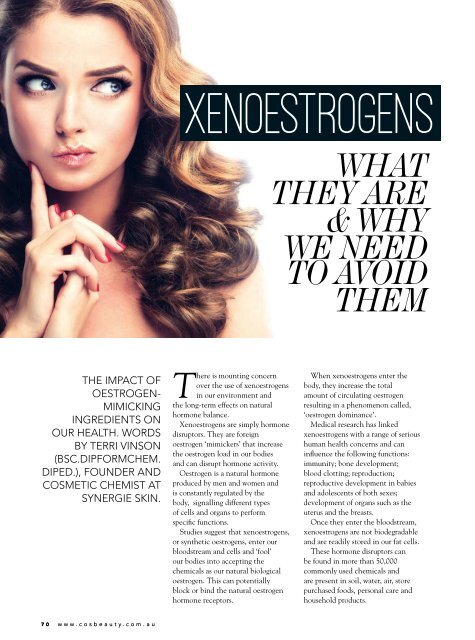CosBeauty Magazine #76
The go to beauty, health and lifestyle magazine for Australians who want to look and feel their best.
The go to beauty, health and lifestyle magazine for Australians who want to look and feel their best.
Create successful ePaper yourself
Turn your PDF publications into a flip-book with our unique Google optimized e-Paper software.
Xenoestrogens<br />
What<br />
they are<br />
& why<br />
we need<br />
to avoid<br />
them<br />
The impact of<br />
oestrogenmimicking<br />
ingredients on<br />
our health. Words<br />
by Terri Vinson<br />
(BSc.DipFormChem.<br />
DipEd.), founder and<br />
cosmetic chemist at<br />
Synergie Skin.<br />
There is mounting concern<br />
over the use of xenoestrogens<br />
in our environment and<br />
the long-term effects on natural<br />
hormone balance.<br />
Xenoestrogens are simply hormone<br />
disruptors. They are foreign<br />
oestrogen ‘mimickers’ that increase<br />
the oestrogen load in our bodies<br />
and can disrupt hormone activity.<br />
Oestrogen is a natural hormone<br />
produced by men and women and<br />
is constantly regulated by the<br />
body, signalling different types<br />
of cells and organs to perform<br />
specific functions.<br />
Studies suggest that xenoestrogens,<br />
or synthetic oestrogens, enter our<br />
bloodstream and cells and ‘fool’<br />
our bodies into accepting the<br />
chemicals as our natural biological<br />
oestrogen. This can potentially<br />
block or bind the natural oestrogen<br />
hormone receptors.<br />
When xenoestrogens enter the<br />
body, they increase the total<br />
amount of circulating oestrogen<br />
resulting in a phenomenon called,<br />
‘oestrogen dominance’.<br />
Medical research has linked<br />
xenoestrogens with a range of serious<br />
human health concerns and can<br />
influence the following functions:<br />
immunity; bone development;<br />
blood clotting; reproduction;<br />
reproductive development in babies<br />
and adolescents of both sexes;<br />
development of organs such as the<br />
uterus and the breasts.<br />
Once they enter the bloodstream,<br />
xenoestrogens are not biodegradable<br />
and are readily stored in our fat cells.<br />
These hormone disruptors can<br />
be found in more than 50,000<br />
commonly used chemicals and<br />
are present in soil, water, air, store<br />
purchased foods, personal care and<br />
household products.<br />
70 www.cosbeauty.com.au

















